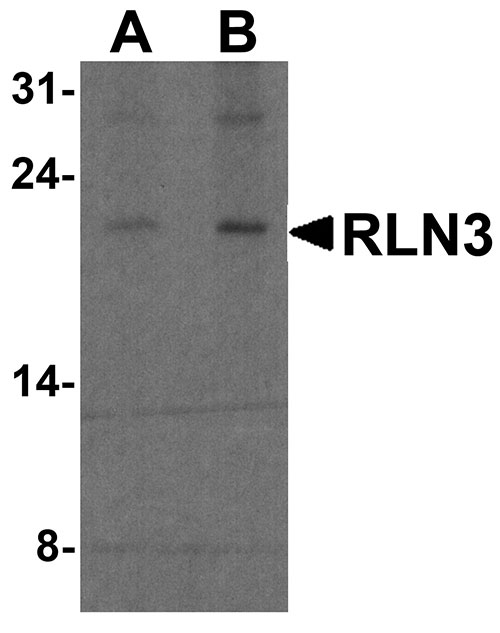RLN3 Antibody
- SPECIFICATION
- CITATIONS
- PROTOCOLS
- BACKGROUND

Application
| WB, IF, E |
|---|---|
| Primary Accession | Q8WFX3 |
| Other Accession | NP_543140, 18254464 |
| Reactivity | Human |
| Host | Rabbit |
| Clonality | Polyclonal |
| Isotype | IgG |
| Calculated MW | Predicted: 16 kDa; Observed: 20 kDa |
| Application Notes | RLN3 antibody can be used for detection of RLN3 by Western blot at 1 - 2 µg/ml. For immunofluorescence start at 20 µg/mL. |
| Gene ID | 117579 |
|---|---|
| Target/Specificity | RLN3; RLN3 antibody is human specific. RLN3 antibody is predicted to not cross-react with other members of the Relaxin protein family. |
| Reconstitution & Storage | RLN3 antibody can be stored at 4℃ for three months and -20℃, stable for up to one year. |
| Precautions | RLN3 Antibody is for research use only and not for use in diagnostic or therapeutic procedures. |
| Name | mt-cyb |
|---|---|
| Synonyms | cob, cytb, mtcyb |
| Function | Component of the ubiquinol-cytochrome c reductase complex (complex III or cytochrome b-c1 complex) that is part of the mitochondrial respiratory chain. The b-c1 complex mediates electron transfer from ubiquinol to cytochrome c. Contributes to the generation of a proton gradient across the mitochondrial membrane that is then used for ATP synthesis. |
| Cellular Location | Mitochondrion inner membrane {ECO:0000250|UniProtKB:P00157}; Multi-pass membrane protein {ECO:0000250|UniProtKB:P00157} |

Thousands of laboratories across the world have published research that depended on the performance of antibodies from Abcepta to advance their research. Check out links to articles that cite our products in major peer-reviewed journals, organized by research category.
info@abcepta.com, and receive a free "I Love Antibodies" mug.
Provided below are standard protocols that you may find useful for product applications.
Background
Relaxin-3 (RLN3) is a member of Relaxin family, a group of endocrine and autocrine/paracrine hormones that belong to the insulin gene superfamily (1,2). RLN3 can bind to and activate three relaxin-family peptide receptors: RXFP1, RXFP3, and RXFP4 (3). In contrast to the widespread expression of the related proteins RLN1 and RLN2, RLN3 is predominantly expressed in brain and to a lesser extent in the thymus, kidney and spleen (1). RLN3 has been suggested to play a role in feeding, metabolism, stress, arousal, learning, and memory (4).
References
Bathgate RA, Samuel CS, Burazin TC, et al. Human relaxin gene 3 (H3) and the equivalent mouse relaxin (M3) gene. Novel members of the relaxin peptide family. J. Biol. Chem. 2002; 277:1148-57.
Wilkinson TN and Bathgate RA. The evolution of the relaxin peptide family and their receptors. Adv. Exp. Med. Biol. 2007; 612:1-13.
Silvertown JD, Neschadim A, Liu HN, et al. Relaxin-3 and receptors in the human and rhesus brain and reproductive tissues. Regul. Pept. 2010; 159:44-53.
Bathgate RAD, Halls ML, van der Westhuizen ET, et al. Relaxin family peptides and their receptors. Physiol. Rev. 2012; 93:405-80.
If you have used an Abcepta product and would like to share how it has performed, please click on the "Submit Review" button and provide the requested information. Our staff will examine and post your review and contact you if needed.
If you have any additional inquiries please email technical services at tech@abcepta.com.













 Foundational characteristics of cancer include proliferation, angiogenesis, migration, evasion of apoptosis, and cellular immortality. Find key markers for these cellular processes and antibodies to detect them.
Foundational characteristics of cancer include proliferation, angiogenesis, migration, evasion of apoptosis, and cellular immortality. Find key markers for these cellular processes and antibodies to detect them. The SUMOplot™ Analysis Program predicts and scores sumoylation sites in your protein. SUMOylation is a post-translational modification involved in various cellular processes, such as nuclear-cytosolic transport, transcriptional regulation, apoptosis, protein stability, response to stress, and progression through the cell cycle.
The SUMOplot™ Analysis Program predicts and scores sumoylation sites in your protein. SUMOylation is a post-translational modification involved in various cellular processes, such as nuclear-cytosolic transport, transcriptional regulation, apoptosis, protein stability, response to stress, and progression through the cell cycle. The Autophagy Receptor Motif Plotter predicts and scores autophagy receptor binding sites in your protein. Identifying proteins connected to this pathway is critical to understanding the role of autophagy in physiological as well as pathological processes such as development, differentiation, neurodegenerative diseases, stress, infection, and cancer.
The Autophagy Receptor Motif Plotter predicts and scores autophagy receptor binding sites in your protein. Identifying proteins connected to this pathway is critical to understanding the role of autophagy in physiological as well as pathological processes such as development, differentiation, neurodegenerative diseases, stress, infection, and cancer.



